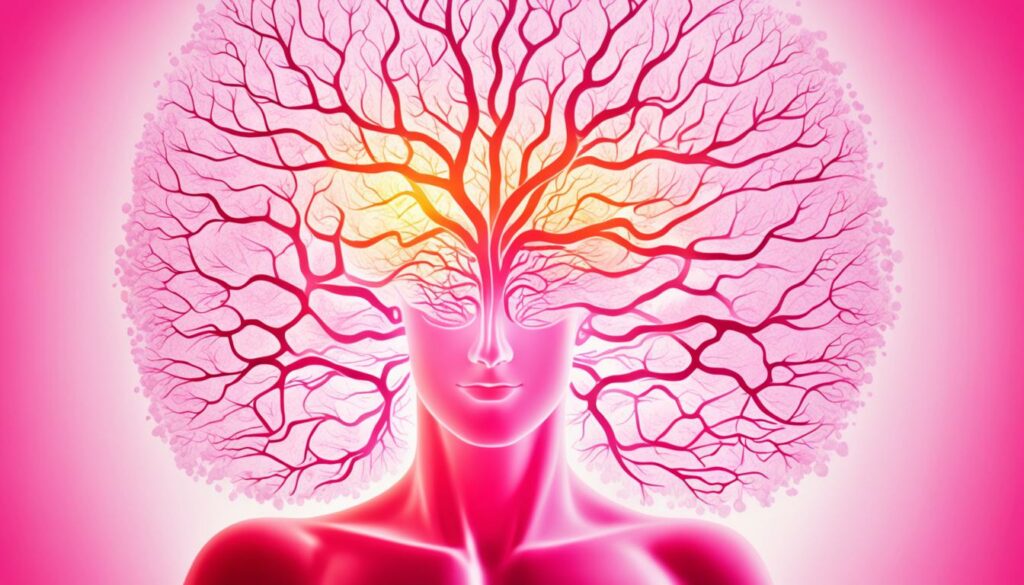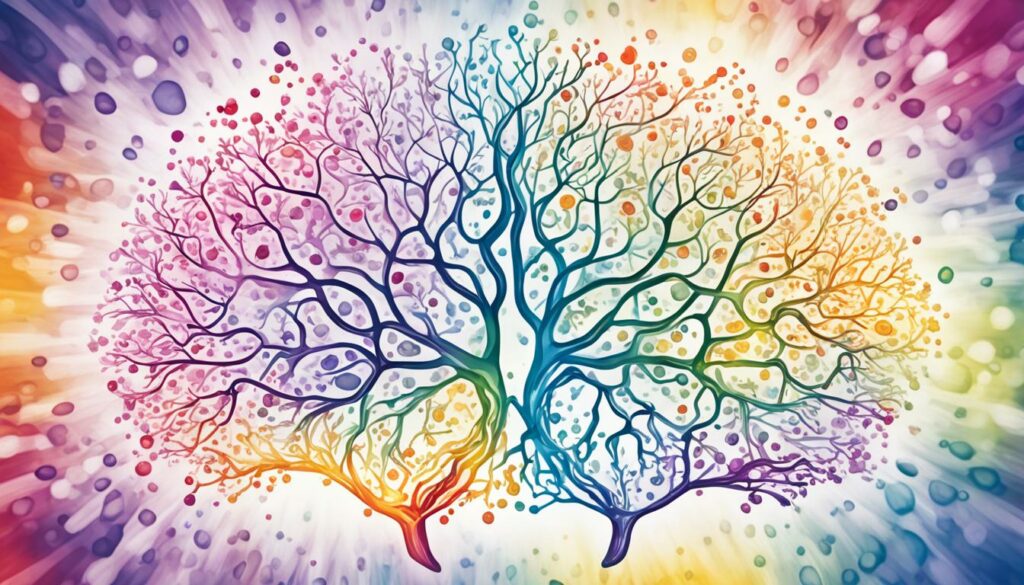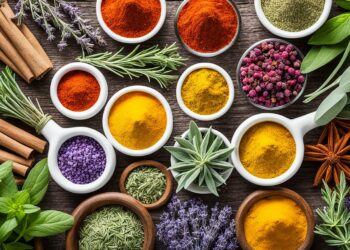Did you know that oxytocin, the so-called love hormone, plays a crucial role in sexual arousal dynamics? This powerful hormone, along with its partner vasopressin, influences our emotions, bonding, and overall well-being.
Its impact on sexual desire and pleasure is nothing short of astonishing. Let’s dive into the fascinating world of oxytocin and explore its benefits for sexual arousal, as well as natural ways to increase its production.
Key Takeaways:
- Oxytocin, along with vasopressin, is involved in mediating selective sociality and shaping our relationships.
- Sexual behavior is regulated by complex interactions between the nervous and endocrine systems.
- The neurobiological basis of sexual arousal involves both subcortical and cortical brain areas.
- Oxytocin’s evolutionary significance is tied to the formation of social bonds and partner preferences.
- Exploring natural ways to increase oxytocin release can enhance sexual desire and intimacy.
The Neurobiological Basis of Sexual Behavior
Sexual desire, arousal, and orgasm are complex processes that involve intricate interactions within the somatic and autonomic nervous systems.
The central nervous system, which includes subcortical structures like the hypothalamus, brainstem, and spinal cord, as well as cortical brain areas, plays a critical role in regulating sexual behavior.
Various neurotransmitter systems contribute to the intricate web of sexual response, with dopaminergic and serotonergic systems standing out as particularly important.
“Understanding the neurobiological basis of sexual behavior provides valuable insights into the role of oxytocin in sexual response.”
Dopamine, a neurotransmitter associated with reward and motivation, is involved in the anticipation and experience of sexual pleasure. It promotes feelings of arousal and contributes to the motivation to engage in sexual activity.
Serotonin, on the other hand, plays a role in modulating sexual desire, with higher serotonin levels often associated with reduced interest in sexual activities.
The hormone oxytocin, known for its role in promoting social bonding and trust, also plays a significant role in sexual response. Oxytocin is released during sexual activity and is thought to contribute to feelings of intimacy and pleasure.
Research suggests that oxytocin may enhance sexual arousal and facilitate bonding between partners. Its release during sexual activity may help reinforce positive experiences and deepen emotional connections.
The Role of Oxytocin in Sexual Response
Oxytocin, often referred to as the “love hormone,” has been found to modulate sexual arousal, desire, and orgasm in both men and women. In males, oxytocin has been linked to erectile function, facilitating blood flow to the penis and promoting sustained erections.
In females, oxytocin contributes to clitoral engorgement, increased lubrication, and heightened sensations during sexual activity. It also promotes the rhythmic contractions of the pelvic muscles that accompany orgasm.
The release of oxytocin during sexual activity is influenced by various factors, including physical touch, emotional connection, and sexual stimulation.
It is believed that oxytocin helps create a positive feedback loop, reinforcing the pleasure and satisfaction associated with sexual experiences and promoting bonding between sexual partners.
Understanding the neurobiological basis of sexual behavior, including the role of oxytocin, provides valuable insights into the intricate dynamics of sexual response.
By exploring the natural ways to increase oxytocin release, individuals can potentially enhance their sexual arousal, foster intimacy, and cultivate fulfilling sexual relationships.
Neural Mechanisms of Sexual Arousal in Humans
The neural mechanisms underlying sexual arousal involve a complex interplay between subcortical and cortical brain areas. Several key factors contribute to sexual desire, which is regulated by the hypothalamus and the limbic system.
Understanding how these neural networks function can shed light on the role of oxytocin in sexual desire and intimate experiences.
For males, sexual arousal is characterized by the phenomenon of erection. This physiological response is mediated by the autonomic nervous system and involves the release of nitric oxide, which promotes vasodilation and engorges the penile tissues.
This process is influenced by the interplay of various neurotransmitters and hormones, including oxytocin. The effects of oxytocin on sexual pleasure and intimacy are still being studied, but it is believed to play a vital role in enhancing sexual experiences.
Females experience sexual arousal through engorgement of the clitoris and lubrication. Clitoral hemodynamics, regulated by the autonomic nervous system, contribute to sexual pleasure and responsiveness.
Oxytocin is thought to influence sexual arousal in females as well, although its specific effects are still under investigation.
The culmination of sexual arousal is orgasm, which is a complex physiological and psychological process. During orgasm, both males and females experience various muscle contractions throughout the body, including the pelvic region.
Heart rate and blood pressure also increase significantly. While oxytocin’s exact role in orgasm is not fully understood, its release is known to be associated with pleasurable sensations and feelings of bonding.
| Key Neural Mechanisms of Sexual Arousal | Rôle of Oxytocin |
|---|---|
| Activation of subcortical and cortical brain areas | Influences sexual desire and pleasure |
| Erection in males | Mediates autonomic response and enhances pleasure |
| Clitoral hemodynamics and lubrication in females | Potential influence on sexual arousal |
| Orgasmic muscle contractions and increased heart rate | Associated with feelings of bonding and pleasure |
Understanding the neural mechanisms of sexual arousal and the influence of oxytocin can have significant implications for enhancing sexual desire, pleasure, and intimacy. Further research into the specific roles and interactions of oxytocin in the context of sexual experiences is needed to fully grasp its potential benefits.

The Evolutionary Significance of Oxytocin and Monogamy
Oxytocin, a hormone with ancient origins, plays a significant role in various aspects of social behavior and bonding. The evolution of specific mammalian physiology related to oxytocin occurred approximately 200 million years ago.
Research on prairie voles has provided valuable insights into the role of oxytocin in the formation of social preferences and partner bonds.
“Oxytocin is involved in the formation of partner preferences and bonds.” – Research Study
In both voles and humans, monogamy is a social system influenced by oxytocin and other molecules. Oxytocin’s importance extends beyond social bonding and into emotional regulation, highlighting its significance in positive social behaviors and aggression control.
Oxytocin’s Role in Emotional Regulation
Oxytocin has been shown to have a direct impact on emotional regulation. It helps reduce stress and anxiety levels, promoting a sense of calm and well-being. By enhancing social bonding and reducing fear, oxytocin fosters an environment conducive to emotional stability and positive relationships.
The Impact of Oxytocin on Sexual Desire, Erection, and Orgasm
Although oxytocin is commonly associated with emotional bonding, it also influences sexual desire, erection, and orgasm. Research has demonstrated that oxytocin levels increase during sexual arousal and peak during orgasm.
Oxytocin acts on various physiological processes involved in sexual response. In males, it promotes blood flow to the penis, leading to erection. Nitric oxide release, facilitated by oxytocin, plays a vital role in initiating and maintaining the physiological changes necessary for sexual arousal and erection.
In females, oxytocin contributes to clitoral hemodynamics and lubrication, enhancing sexual pleasure and facilitating orgasmic response.

Understanding the evolutionary significance of oxytocin provides a deeper appreciation for its role in promoting social bonding, emotional regulation, and sexual satisfaction. By exploring natural ways to increase oxytocin release, individuals can enhance intimacy, strengthen relationships, and improve the quality of their intimate experiences.
The Journey to Understanding Oxytocin
The exploration of oxytocin’s role in behavior was driven by the researcher’s personal journey and a deep curiosity to understand the biology behind positive experiences and nurture. This interest was shaped by early experiences and studying social behaviors in animals such as guinea pigs and prairie voles.
The focus on early experience, maternal behavior, and social behavior eventually led the researcher to study oxytocin and its impact on human sexuality. Overcoming challenges and a desire to unlock the secrets of oxytocin’s benefits for sexual arousal drove the exploration further.
“The more I delved into the fascinating world of oxytocin, the more it became clear that this hormone plays a pivotal role in our emotional and sexual lives.”
Unraveling the mysteries of oxytocin and its natural ways to increase sexual arousal has become a personal mission for the researcher. The journey has been filled with breakthroughs, a deeper understanding of the mind and body connection, and the profound influence oxytocin holds over our intimate experiences.
The Bonding Power of Oxytocin
One of the remarkable functions of oxytocin is its ability to foster deep emotional bonds and enhance sexual intimacy. When released during acts of physical closeness, oxytocin promotes feelings of trust, love, and connection, making it a vital hormone in sustaining healthy relationships.
Research has shown that oxytocin can enhance sexual pleasure and intensify orgasms. It helps facilitate the release of endorphins, the body’s natural “feel-good” chemicals, further amplifying the sensations of pleasure during sexual experiences.
Natural Ways to Boost Sexual Arousal
There are several natural methods to increase sexual arousal and stimulate the release of oxytocin:
- Engaging in intimate and meaningful conversations with your partner to foster emotional connection.
- Engaging in physical touch and affectionate gestures, such as hugging, holding hands, or cuddling.
- Practicing mindfulness and relaxation techniques to reduce stress and increase receptiveness to pleasure.
- Engaging in regular exercise, which promotes overall well-being and enhances sexual vitality.
- Exploring new sexual experiences and fantasies with consent and open communication.
By incorporating these natural ways into your life, you can promote the release of oxytocin, heighten sexual arousal, and experience more fulfilling intimate connections.
Understanding oxytocin’s benefits for sexual arousal and exploring natural ways to harness its power can unlock a new level of intimacy and enhance the quality of your intimate experiences.
| Benefits of Oxytocin for Sexual Arousal | Natural Ways to Increase Sexual Arousal |
|---|---|
| Promotes emotional and physical bonding | Engaging in intimate conversations |
| Enhances sexual pleasure and intensifies orgasms | Engaging in physical touch and affectionate gestures |
| Increases feelings of trust, love, and connection | Practicing mindfulness and relaxation techniques |
| Reduces stress and enhances receptiveness to pleasure | Engaging in regular exercise |
| Improves overall well-being and sexual vitality | Exploring new sexual experiences and fantasies |
By leveraging the benefits of oxytocin and adopting natural ways to increase sexual arousal, individuals can enhance their sexual experiences and foster deeper connections with their partners.
Conclusion
Oxytocin, the “love hormone,” plays a crucial role in sexual desire and response. Its influence on social bonding and emotions makes it essential for healthy sexuality and overall well-being.
By delving into the neural mechanisms behind sexual behavior and the evolutionary significance of oxytocin, we gain valuable insights into the dynamics of human sexual arousal.
Understanding how oxytocin affects sexual desire and response allows us to explore natural ways to enhance sexual arousal. By stimulating oxytocin release, we can improve intimacy and enhance the quality of intimate experiences.
From engaging in activities that promote emotional connection, like cuddling and sharing intimate moments, to practicing mindfulness and stress reduction techniques, there are various ways to naturally boost oxytocin levels and increase sexual arousal.
Striving for a healthy sexual life involves recognizing the importance of oxytocin and its role in promoting intimacy and emotional well-being. By incorporating natural methods to increase oxytocin and prioritize emotional connections, we can nurture our sexual desires and forge more fulfilling sexual experiences.
So, take the time to explore the power of oxytocin and discover the natural pathways to enhanced sexual arousal.
FAQ
What is the role of oxytocin in sexual arousal?
Oxytocin plays a significant role in sexual arousal and desire. It is a critical hormone for healthy sexuality and overall well-being.
Can oxytocin benefit sexual arousal?
Yes, oxytocin has been shown to have positive effects on sexual arousal. It helps enhance intimacy and improve the quality of intimate experiences.
Are there natural ways to increase sexual arousal through oxytocin release?
Yes, engaging in activities that promote emotional connection and bonding, such as hugging, cuddling, and intimate conversations, can boost oxytocin levels and enhance sexual arousal.
What is the relationship between oxytocin and sexual pleasure?
Oxytocin is involved in the regulation of sexual pleasure. It helps to create feelings of pleasure and satisfaction during sexual experiences.
How does oxytocin contribute to sexual intimacy?
Oxytocin plays a role in promoting feelings of trust, bonding, and emotional intimacy, which are essential for healthy sexual relationships.
What is the role of oxytocin in sexual desire?
Oxytocin influences sexual desire by regulating the hypothalamus and limbic system, which are involved in the regulation of sexual behavior.
What is the role of oxytocin in sexual response?
Oxytocin is involved in the neural mechanisms underlying sexual arousal and response. It helps regulate processes such as erection and orgasm.
How does oxytocin contribute to the evolution of monogamy?
Oxytocin, along with other molecules, influences social bonding and partner preference. It has been implicated in the formation of social bonds and plays a role in the evolution of monogamy in both humans and other mammals.




